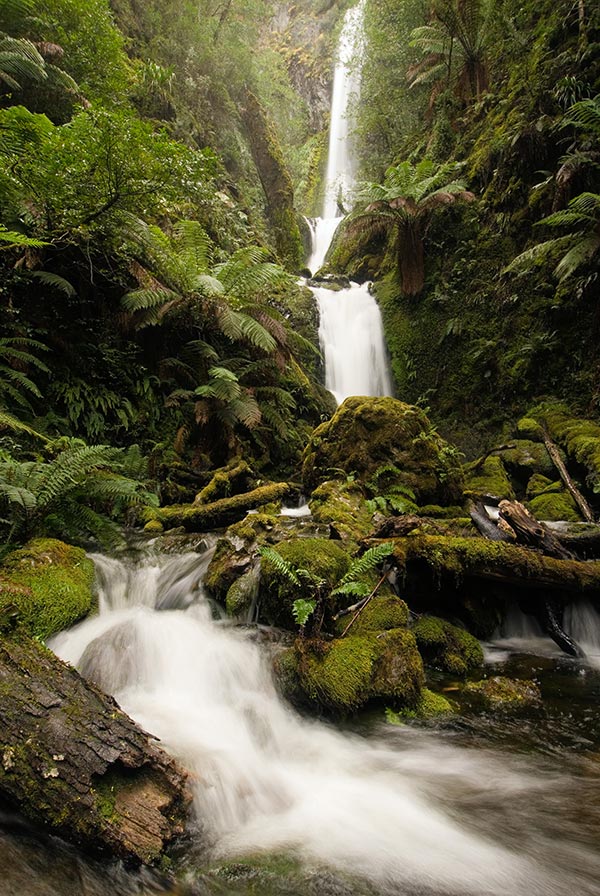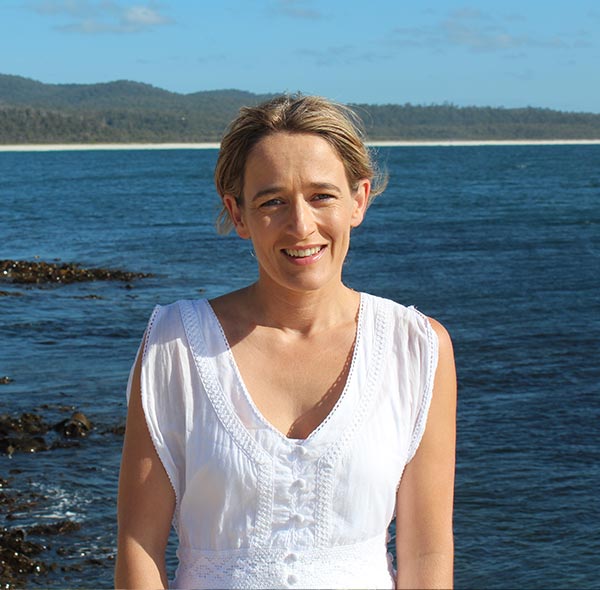One of Tasmania’s pristine waterfalls.
Image: Grant Dixon Photography.

The story behind Vanishing Falls
William Morrow, Harper Collins, August 2020
A stranger, seeing Tasmania for the first time, might not immediately be struck by the beauty of the island. They might see a bleak landscape, dotted with sheep as parched in colour as the pasture, vast tracts of dry eucalypt forests, tea-tree stained lagoons, powerful ocean crashing on rugged headlands and bright-white beaches. It can take time for a person to appreciate Tasmania’s magnificent yet fragile, raw beauty.
This contradiction is one of the reasons why I like writing about Tasmania. As most writers do, I have a box of unpublished novels, poems and screenplays. All of mine are studies of different landscapes on the island, from the ski fields to the farmlands and undulating poppy fields. Tasmania has a strange beauty: a dangerous terrain gilded with delicate flora, impossibly high waterfalls that vanish into subterranean creeks, ancient forests and deceptively beguiling oceans. Best of all, are the wide range of diverse people who call the island home.
This novel, Vanishing Falls, is set in a fictional garrison town in the rainforest beneath the Gog Range, somewhere between Mole Creek and the Mersey River valley. I thought often of Westbury, an old garrison village, as I was writing about Vanishing Falls village.
Many years ago, I was intrigued by a sad story I read in the newspaper about a young girl who was caught up in a horrible crime. It wasn’t her fault; she was young and from a disadvantaged background. The price she paid for witnessing this crime was the community’s, and her family’s, rejection of her. I felt immense sympathy for this girl and the woman she would become. I had the idea to write her a happy ending, where she ends up surrounded by people who accept and love her. That’s where the character Brian comes in: a beautiful man who wanted to look after Joelle and keep her safe. Joelle brings him a deep happiness. To me, they exemplify what happens when people are genuine and kind to each other. Exuberant and joyful, Joelle is different to most people – she can’t think as quickly, she struggles to read social situations well. My character is not based on any one I know, although there have been special people in my life who faced similar struggles to Joelle.
I was born in Tasmania and grew up on a small farm near Launceston. The river city is bursting with well-preserved Georgian buildings and elegant parks. The surrounding countryside is dotted with historic villages, inns, churches, homesteads, and convict-built roads and bridges. One of the prominent heritage-listed homes is Mona Vale, in Ross, which is a privately-owned home sometimes called the calendar house. There are many beautiful homesteads in Tasmania and it’s easy to become enchanted by these grand old homes. These homes are also a reminder of Tasmania’s dark colonial history, in which Tasmanian Aboriginal people had their land stolen, their families murdered, and endured terrible abuse. In my novel, this is referred to in the various ways characters respond to the artwork of John Glover, an English artist who lived in northern Tasmania from 1831. As the granddaughter of a man who wondered about his indigenous ancestry, I was thinking about questions of belonging.
Apple-growing in Tasmania has a romantic history. Festivals used to be held to bless the blossoming apple trees in spring, and again in autumn to celebrate the harvest. There were float parades, balls, apple queens were crowned, and competitions held to showcase the skills of the orchardist. These festivals are currently being reborn in the Huon Valley and Spreyton in the north, for tourism reasons.

Writer Poppy Gee in the Bay of Fires, Tasmania.
The story behind Bay of Fires
Little, Brown; Headline Review; Hachette Australia, 2013
My first novel Bay of Fires is set in a seaside village in the Bay of Fires region on the east coast of Tasmania, a tiny island at the southern end of Australia’s mainland. I’ve imagined a fictional village within the real-life national park.
Our family had a shack in the Bay of Fires area – a dilapidated beer barrel shaped Nissen Hut shack, full of rats and spiders – and it inspired the guesthouse in my novel. I had a lovely childhood, we spent every school holiday at the beach, as well as many weekends. There were only a few shacks in those days, and no phones or electricity, and visitors were limited by a ruinous sand and gravel road that provided the only access. For children, there was nothing to do but explore the beaches, coves, lagoons and forest. I can easily imagine every rock formation on the beach, the way the water ripples around the headland, the many shades and textures of the sand, and the shape of the kelp under the water as you snorkel through the reefs, and that numbing feel when you dive into the deceptively tropical-looking water.
When I was a teenager, a woman disappeared while riding her bicycle down a quiet coastal highway on the east coast of Tasmania. Two years later, a second woman was murdered on a nearby beach. It rocked our quiet island, and at the time, you could not walk into a pub or sit with a group of friends without people speculating on who was responsible. I was intrigued, not so much by the murder or the disappearance, as by the way the community reacted. There was a macabre voyeurism in how we all treated the crime case.
For a novelist, Tasmania provides lots of inspiration with its isolated villages, quiet seaside settlements and dense bushland. Even simple activities such as boating, fishing and bushwalking are potentially deadly. Tasmanian vegetation grows across itself, forming a canopy through which a searching helicopter would not see a person lost on the forest floor. Dirt roads wind through the bush, sometimes passing an abandoned house, or an old tin-can letterbox marking the long driveway of the permanent camp of someone who does not want to be found.
Australian literature, art and film have a long fascination with the unsettling nature of the wilderness. Frederick McCubbin’s famous 1886 painting, Lost, was inspired by the real-life case of a young girl being lost in the bush for three weeks. Banjo Patterson wrote a poem about a boy who fell from his horse and was never found. One of Tasmania’s most acclaimed writers, Christopher Koch, also explored how the threat of the bush is entrenched in his characters’ psyche. In tales such as these, the fear is driven by the deep discomfort we have with the uncharted, uncontrollable wilderness.
They say the scraps for a story come from many cupboards. This is especially true for a first novel. My background is as a newspaper journalist, and I used some of this knowledge to create Hall Flynn. Two close friends of mine are fish farmers. I interviewed them and their poetic descriptions of what they love about their job are reflected in Sarah Avery’s passion for her profession. I wrote Bay of Fires as part of a Masters in Creative Writing at the University of Queensland, for which I received the Dean’s Award for Excellence. Part of my thesis work involved researching the literary history of the spinster figure. Traditionally, the single woman character has been marginalised and mistreated. I wanted to revise this pattern, so the single women in Bay of Fires are all strong, independent, empowered and they drive the narrative.
Like most primary care givers, the biggest challenge I face is finding the solitude to write. When I started writing Bay of Fires, my daughter was a newborn. I used to set my computer up on the kitchen table, and open the Word document, and place my lunch and drink on the table. I would feed the baby and put her to bed and then rush to write as much as I could until she woke up. When my son was born 17 months later, my biggest achievement was synchronising their sleep times. These days, with a house often brimming with busy kids, I like to visit the local library at Toowong or Indooroopilly in order to write. I’m so thankful for public libraries!

